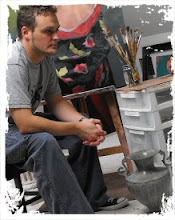Billy Seccombe
www.billyseccombe.om
https://twitter.com/wseccombe
6 Ideas for Better Painting Compositions
Over the past 25 years, I've heard my friend Jack Beal address art students on the critical importance of pictorial composition—the ways in which artists can develop their paintings to create a convincing illusion of space and to direct viewers' attention toward the elements of primary or secondary importance. Some of his advice is commonly offered by other art teachers, but many of his recommendations are not generally understood or consistently applied. Here is some of the advice Beal and other knowledgeable teachers offer their students.
- Avoid putting the center of interest in the middle of the painting. It's very hard to engage viewers in a complete painting if they are focused on what's happening in the middle, or the "dead center," as it is appropriately called. It's better to move the horizon line up or down in a landscape, to make the focal point into one of the four quadrants of the rectangle, or to use one of the time-tested principles such as the golden mean to determine the best placement of the center of interest.
- Use a diagonal shape to bring the viewer into the painting from the bottom. Think of the bottom edge of a painting as a ledge the viewers have to cross to enter the space. If you show them where they can easily step over that ledge, they are more apt to feel invited into the picture. The diagonal can be established by a large, dark clump of bushes in the foreground; a road or pathway to walk along; a knife lying on the edge of a table pointed to the rest of a still life arrangement; or a shaft of light coming from over the viewer's shoulder into the space.
Once you have persuaded the viewers to enter the painting, it is helpful to lead them through the space and out again. Don't take them down a road that ends in the middle of the painting or suggest they follow a piece of cloth that disappears behind a box within your still life arrangement. Use a well-defined diagonal shape to lead viewers out of the painting. - Recognize that fences, roads, railroad tracks, and other pathways are like arrows pointing viewers' eyes in a specific direction. Make sure that if you point them toward one area of the painting you don't leave them there.
- Don't shy away from leaving some areas of the painting open and airy. Many people who work from photographs fail to adjust for the fact that the camera has a limited depth of field and will only document what happens within a narrow space. When they paint from those photographs, they wind up filling their paintings with all the leaves and flowers shown in their close-up shots or with just the foreground elements of a landscape. Since everything in the background of their photographs is a blur, they don't know how to develop those sections of their paintings. That's why it helps to take a lot of photographs of a potential painting subject—details, overall shots, various exposure settings, etc.—so that you have enough information to paint a complete view of the subject.
- Consider repeating colors, shapes, and patterns to help create interest throughout the painting. This is one of the "rules" of composition that often gets repeated, and it certainly has merit. If you only have one red object in your still life, it will overwhelm the rest of the picture. If you only have one orange shape in your landscape, it will likely become the focal point of the image. The best thing to do is to repeat colors, shapes, and patterns. You don't need the exact same mixture of red or the same textural pattern. Just make sure to maintain some level of repetition and variety.
- Try to look at the paintings objectively: Turn your paintings upside down or look at them in a mirror. Put them away for a few days. We all become so completely engaged in our drawings and paintings that we can't judge them objectively. It helps to turn the image upside down, put it away for a while, or look at it in a mirror so you begin to see it differently and can therefore recognize how to improve it.
Editor-in-Chief





I think all of these ideas are great to absorb when you're figuring it all out in the beginning...but at some point you I think you've gotta throw it all out the window and just go instinctual!
ReplyDelete